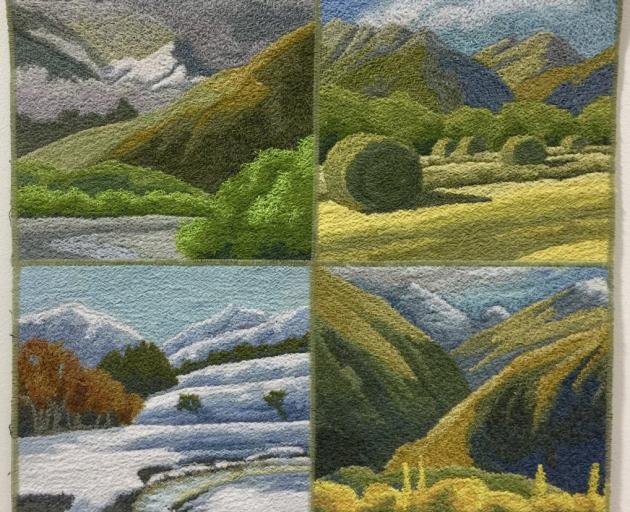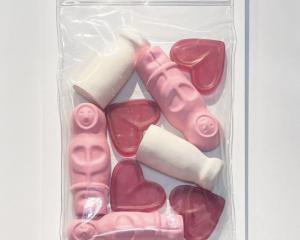In this week's Art Seen, Laura Elliott looks at exhibitions from Central Stories Museum & Art Gallery, Sheena Lassen, and Eric Schusser.
 Four Seasons, by Amanda Hasselman
‘‘17 Degrees: Diversity of Distance’’, RATG and COOTS (Central Stories Museum & Art Gallery, Alexandra)
Four Seasons, by Amanda Hasselman
‘‘17 Degrees: Diversity of Distance’’, RATG and COOTS (Central Stories Museum & Art Gallery, Alexandra)

A single wooden door, locked, mysterious, alive with possibilities as to where it might lead. A pelican, alert, a little wary, alone in murky waters and surrounded by a menacing lattice of encroaching branches.
An old wooden shed, dark, weathered and a little eerie, standing against the skeletal limbs of a broken tree, almost lost in the shadows of towering bush. The glorious burst of gold-flecked colour in an Australian opal, blooming as if the lushest garden has been pulled into fabric and stitched in place.
A landscape almost exploding outwards, consumed by fire. These scenes and many more line of the walls of Central Stories in Alexandra, intricately rendered in felt, wool, leather, silk, even bark. This is “17 Degrees: Diversity of Distance”, a collaborative exhibition between the textile artists of Central Otago Outside the Square (COOTS) and Brisbane’s Reddy Arts Textile Group (RATG).
Every work in the collection is multifaceted, created through numerous artistic processes, and the result is powerfully effective. Many of the fibres used are hand-dyed by the artists, who draw on their surroundings for inspiration, depicting the land, family history, local stories, the wonders and the devastation of nature, all woven — metaphorically and literally —into the imagery. This is art where the hand of the creator is felt and seen in every detail.
 Upper Manuherikia Valley, by Sheena Lassen
‘‘Tussock Country’’, Sheena Lassen (Eade Gallery, Clyde)
Upper Manuherikia Valley, by Sheena Lassen
‘‘Tussock Country’’, Sheena Lassen (Eade Gallery, Clyde)

The glazed surfaces of Sheena Lassen’s landscape paintings glitter in the sunshine, sending a ripple of light across the waters of Lake Alexandrina and highlighting the warm glow of Upper Manuherikia Valley. The real shadows cast through the gallery windows add another layer to those skilfully worked into the canvas by Lassen’s brush.
Largely self-taught, Lassen has a strongly representational style and a knack for the seamless transition from warm to cool tones, as the eye moves from a light-drenched tussocky foreground towards the shaded mountains, draped along the horizon like a snowy blanket.
Works such as Teviot Valley Landscape are photographically realistic, encouraging you to step into the picture plane and follow the rise and fall of the land, enjoy the sense of perfect, remote stillness. There is an almost storybook glimmer to many of the canvases, however, a smooth glossiness to the brush curves and a surreal intensity to the jewel-toned lake waters.
There is no human presence in any of the scenes, and although it isn’t a stretch to imagine some mystical presence living within those borders, it perhaps wouldn’t be the ordinary footprint of man. The world outside the windows — but seen through a lens of perfection, lifted out of the mundane, imbued with just a sprinkle of magic.
 Road cones in church car park triptych, by Eric Schusser
‘‘Urban’’, Eric Schusser (Hullabaloo Art Space, Cromwell)
Road cones in church car park triptych, by Eric Schusser
‘‘Urban’’, Eric Schusser (Hullabaloo Art Space, Cromwell)

When life changes in the blink of an eye, and the normality of the daily routine is suddenly upended, the feeling of losing control over our own lives can be almost as difficult as the events that precipitated it. If the world suddenly feels in chaos, we need an anchor, a safe harbour, to settle and to think and feel, rebuild strength and then continue on.
For many people, that refuge is often found in the arts, a creative outlet to express emotion and share comfort. Photographer Eric Schusser’s latest exhibition ‘‘Urban’’ captures slices of city life — road markings, an upended traffic cone, the neon-yellow glow of an industrial pipe — but tells the story of being in a new place, temporarily, unwillingly, yet finding unexpected beauty even within a seemingly unwelcome environment.
The collection follows the journey that Schusser and his wife, artist Annemarie Hope-Cross, have taken since her cancer diagnosis, and in the sharp, centred imagery of his photographs — the traffic cones pointing in every direction; the road signs zig-zagging up, down, back, forward — there is a strong sense of momentary bewilderment, trying to regain solid footing.
But there is also steadiness and endurance in the Cut tree in a footpath and serenity and warmth in the still life of a vase of flowers and its mirrored reflection, a linking presence to Hope-Cross’ own frequent studies of flora.
- By Laura Elliott








![Untitled (c. mid 1990s, [pink 3]), by Martin Thompson, 415mm×590mm. Photo: courtesy of Brett...](https://www.odt.co.nz/sites/default/files/styles/odt_landscape_small_related_stories/public/story/2024/02/untitled_pink_3.jpg?itok=Q0aQrc9o)



